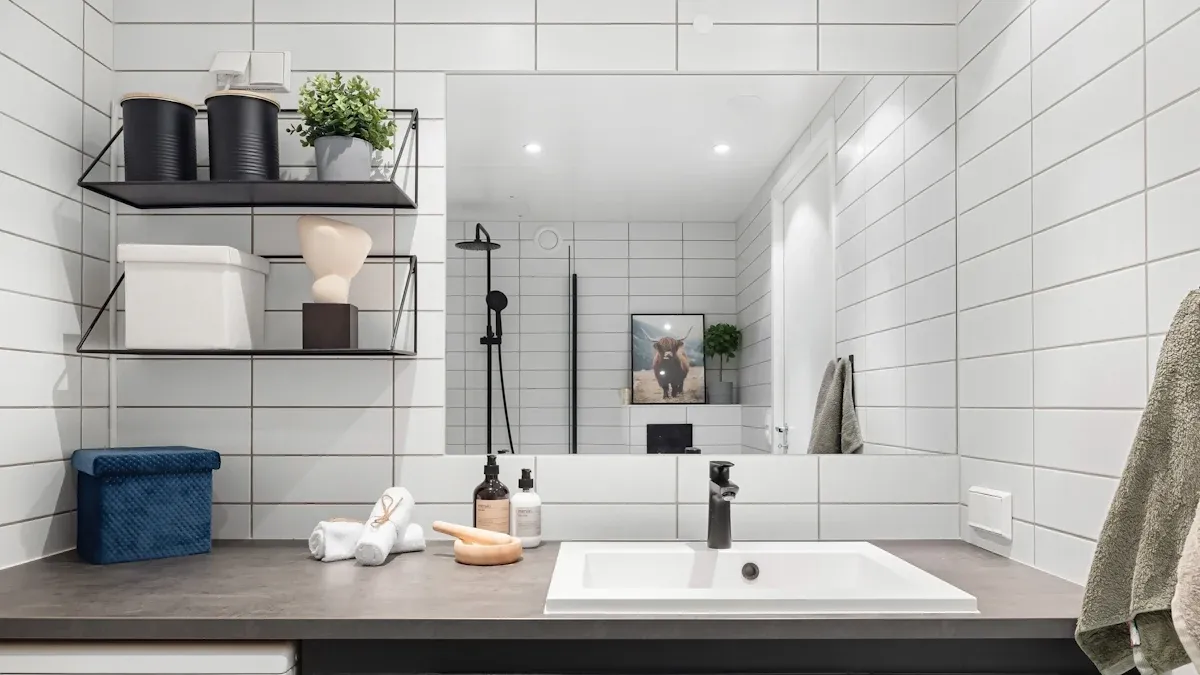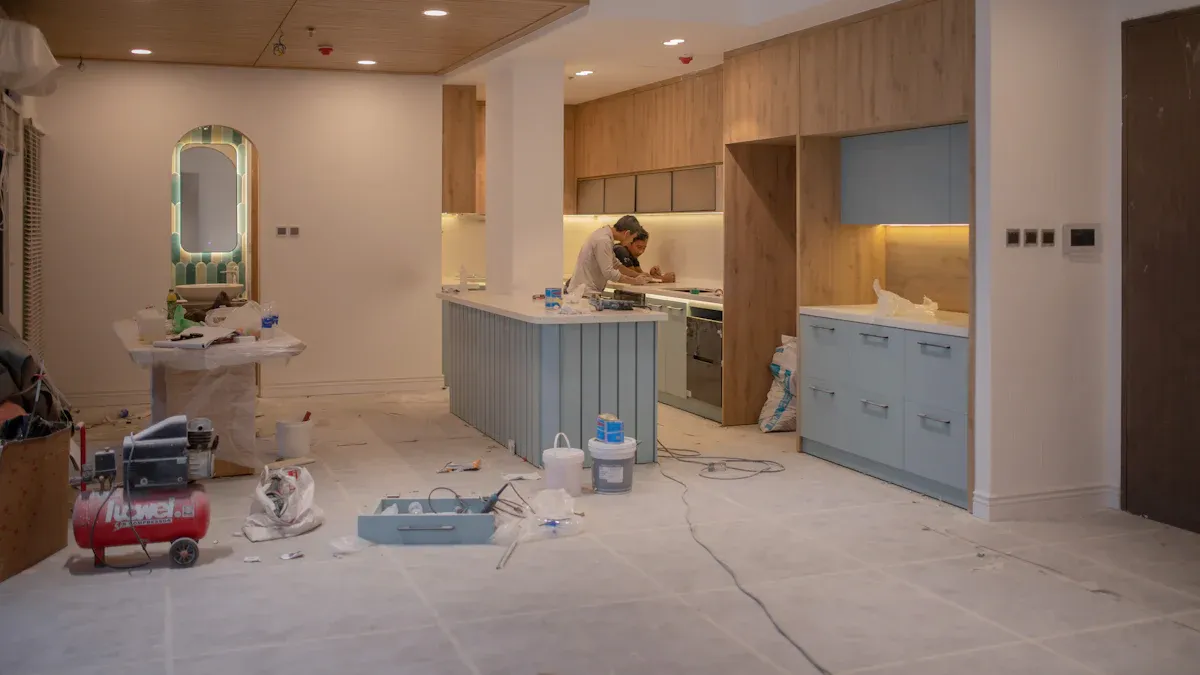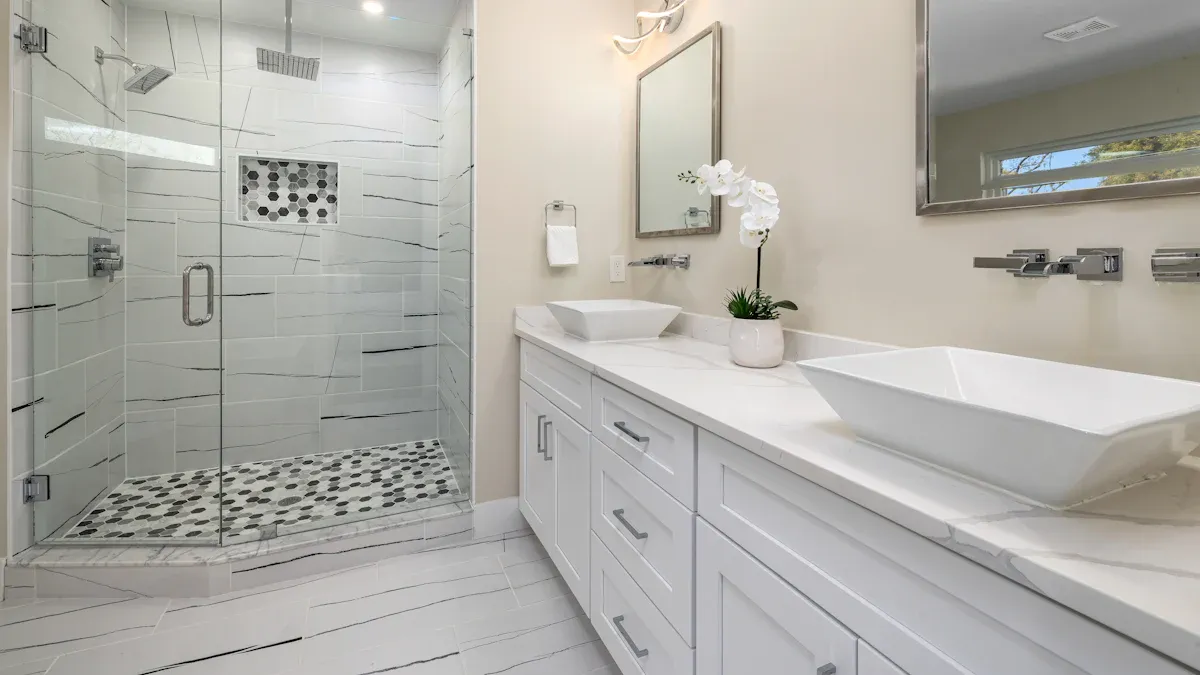
 FEEDBACK
FEEDBACK
If you are interested in our products and want to know more details, please leave a message here, we will reply you as soon as possible.


You can paint bathroom cabinets like a pro, even if this is your first time. Many people run into common mistakes when they start, but you can avoid them with a little care:
Skipping primer often leads to stains and poor paint adhesion.
Rushing the drying time between coats may cause bubbling or peeling.
Painting in dim light makes it easy to miss spots.
Thick paint coats create drips and uneven finishes.
Forgetting to sand between coats leaves brush marks and rough spots.
Bathrooms have extra moisture and tight spaces, so these problems happen a lot. With the right tools, patience, and simple steps, you can get a smooth, lasting finish.

Before you start, gather everything you need. Having the right supplies makes the job easier and helps you get a smooth, lasting finish. Here’s a handy table to help you organize your shopping trip:
Category | Recommended Materials/Tools | Notes |
|---|---|---|
Paint Kits | Rust-Oleum Cabinet Transformations Kit, Beyond Paint All-In-One, Behr Cabinet and Trim Paint | Kits include deglosser, bond coat, glaze, and top coat; tintable to many colors |
Paints | Behr Premium Cabinet & Trim Enamel, Benjamin Moore Advance, Sherwin-Williams Emerald Urethane, KILZ Tribute | Choose satin or semi-gloss for easy cleaning and moisture resistance |
Brushes | Zibra 2-inch Angled Sash, 1-inch Square Moulding, 1-inch Round Brush | High-quality brushes give smoother results |
Rollers & Trays | 4-inch woven rollers, 7-inch paint trays | Foam rollers work well for flat surfaces |
Prep Materials | 320 grit sandpaper, Frog Tape, gloves, screwdriver, wood filler | For cleaning, sanding, and masking |
Cleaning Tools | Krud Kutter, TSP, microfiber cloths, old toothbrush, bucket, sponge, paint can opener, brush cleaning tool | Clean surfaces and tools for best results |
Tip: Don’t forget a top coat for extra protection, especially in bathrooms with lots of steam.
Picking the right paint and primer is key for a finish that lasts. Bathrooms get humid, so you want products that resist moisture and stains.
Acrylic enamel paints are water-based, low odor, and dry fast. They’re easy to use and clean up with soap and water. These paints work well for most bathroom cabinets, but you might want a top coat for extra durability.
Water-based alkyd paints give a hard, smooth finish and have low fumes. They’re budget-friendly and durable, but you should use a primer first for best results.
Shellac primers block stains and stick to tough surfaces, but they smell strong and need special cleanup. They dry fast but aren’t the best for very humid bathrooms.
Acrylic primers are quick-drying, low odor, and good for most cabinets. They help paint stick and resist mildew.
Oil-based paints last a long time and resist stains, but they take longer to dry and have strong fumes. You’ll need good ventilation if you use them.
Note: Choose satin or semi-gloss finishes. They’re easier to clean and stand up better to bathroom moisture than flat paints.
The right tools make a big difference in how your cabinets look and how long the finish lasts.
Use high-quality synthetic brushes for water-based paints. They help you get crisp edges and fewer brush marks.
Foam rollers are great for flat surfaces. They spread paint evenly and help avoid streaks.
If you want a super-smooth, professional look, you can use a paint sprayer. Sprayers cover evenly but take practice and setup.
Sandpaper (180-320 grit) helps smooth out surfaces before and between coats.
Always clean and sand your cabinets before painting. This step helps the paint stick and prevents peeling.
For extra protection, apply a clear top coat like polyurethane after painting. This seals the surface and keeps moisture out.
Pro Tip: Lightly sand between coats for the smoothest finish. Take your time—thin coats look better and last longer.
Start by taking off all the cabinet doors, drawers, and hardware. Use a screwdriver to remove the hinges, handles, and knobs. Place the hardware in a labeled bag so you do not lose any pieces. Removing these parts helps you reach every surface and makes it much easier to paint bathroom cabinets evenly. You will get a smooth, professional look because you can clean, sand, and paint every edge. Skipping this step often leads to missed spots and paint that peels or chips, especially in a humid bathroom.
Tip: Lay the doors flat on a work surface. This helps prevent drips and makes painting easier.
Next, clean every surface well. Bathrooms collect a lot of grime, so do not skip this step. Spray a degreaser like Krud Kutter on the cabinets and let it sit for about a minute. Use an old toothbrush to scrub corners and edges. Wipe everything down with a damp cloth. For extra cleaning power, mix TSP (trisodium phosphate) with water and wipe the cabinets again. Always wear gloves when using TSP. Finish with a quick wipe using window cleaner to remove any leftover residue. Clean cabinets help the paint stick better and last longer.
Check for dents, scratches, or old hardware holes. Fill these spots with wood filler and let it dry. Once dry, sand the filled areas with medium-grit sandpaper, then switch to a finer grit for a smooth finish. Lightly sand all cabinet surfaces to help the primer and paint grip. You do not need to sand down to bare wood—just scuff the surface. This step makes a big difference in how your cabinets look and how long the paint lasts. If you use a strong bonding primer, you can sometimes skip heavy sanding, but a quick scuff always helps.
Taking time to prep your cabinets now means your paint job will look better and last longer, even in a busy bathroom.

Priming is the secret to a long-lasting, professional finish when you paint bathroom cabinets. You want to use a shellac-based or premium water-based adhesion primer. These primers seal the surface and help the paint stick, which is especially important in a humid bathroom. Shellac primers work well for blocking stains and sticking to glossy finishes, but they have a strong smell and need special cleanup. Water-based primers dry quickly and have less odor, making them a good choice for most homes.
Before you start, make sure your workspace has good ventilation. Open a window or use a fan if you can. Stir the primer well. Use a high-quality angled brush to get into corners and detailed areas. Then, switch to a foam roller for flat surfaces. This combo helps you avoid brush marks and roller lines.
Let the primer dry completely before moving on. Drying times depend on the type of primer and your bathroom’s temperature and humidity. Water-based primers usually dry in 30 minutes to an hour. Shellac and oil-based primers need at least 1 to 2 hours. Always check the label for exact times. If your cabinets are made of raw MDF, a second coat of primer can help seal the surface better. After the primer dries, lightly sand with 220-grit sandpaper to smooth out any bumps or drips. Wipe away dust with a clean cloth.
Tip: Using a tinted primer that matches your paint color can help you get better coverage and use fewer coats of paint.
Now you’re ready to paint bathroom cabinets. Choose a water-based alkyd or acrylic enamel paint for the best results. These paints dry hard, resist moisture, and are easy to clean—perfect for bathrooms. Pick a satin or semi-gloss finishfor extra durability and easy wipe-downs.
Start with a high-quality synthetic brush for edges, corners, and any raised details. Paint with the grain of the wood. Don’t overload your brush; dip just the tip and tap off extra paint. For flat panels and large surfaces, use a foam roller. This helps you get a smooth, even coat without streaks or roller marks. Work in thin layers. Thick coats can drip or bubble, especially in humid rooms.
Keep a “wet edge” as you paint. This means you overlap each stroke while the paint is still wet. Doing this helps blend brush marks and keeps the finish even. If you need to thin your paint a little for smoother flow, add a small amount of water (for water-based paints) and stir well.
Most bathroom cabinets need two to three coats of paint for a flawless finish. Let each coat dry fully before adding the next. Drying times can vary, but plan for at least 2-4 hours between coats. If your bathroom is humid, use a fan or dehumidifier to speed up drying.
Step | Tool/Technique | Why It Works |
|---|---|---|
Angled brush | Covers details without excess paint | |
Roll flat surfaces | Foam roller | Smooths out brush marks |
Keep a wet edge | Overlap strokes | Prevents streaks and lap marks |
Thin coats | Brush/roller | Avoids drips and uneven finish |
Let dry fully | Wait between coats | Improves durability and smoothness |
Pro Tip: Don’t rush. Letting each coat dry completely helps prevent tacky spots and peeling later.
Sanding between coats is the step that makes your cabinets look and feel smooth. Use fine-grit sandpaper—between 150 and 220 grit works best. Lightly sand the surface after each coat of primer and paint. This removes tiny bumps, brush marks, and dust that can settle while the paint dries.
Wipe away sanding dust with a microfiber cloth before you start the next coat. Sanding helps the next layer of paint grip better, which means your finish will last longer and resist chipping or peeling. Professionals always sand between coats to get that flawless, streak-free look.
Light sanding roughens the surface just enough for better paint adhesion.
Multiple thin coats with sanding in between reduce drips and brush marks.
Skipping this step can lead to peeling, uneven color, and a rough texture—especially in a bathroom where moisture is a problem.
Always allow each coat to dry fully before sanding. If the paint feels sticky, wait a bit longer.
Note: Sanding and patience are your best friends for a smooth, professional finish when you paint bathroom cabinets.
You’ve put in a lot of work to paint bathroom cabinets, so don’t rush this last step. Let each coat of paint dry fully before adding another. After your final coat, wait at least 24 hours before touching or moving the doors and drawers. If you can, let them dry for one to two days before putting everything back together. Paint needs time to cure, which means it gets harder and stronger over about one to two weeks. During this time, handle your cabinets gently. If you close doors too soon, they might stick or peel. Bathrooms have lots of steam, so open a window or use a fan to help the paint cure. Good airflow keeps your finish looking smooth and helps it last longer.
Tip: Always follow the drying and curing times on your paint can for the best results.
Once your cabinets feel dry to the touch, you can start reassembling. Put the doors and drawers back in place. Reattach the hinges, handles, and knobs. This is a great time to update your hardware for a fresh look. Try matte black pulls, warm gold handles, or even vintage glass knobs. Mixing styles and finishes can add personality to your bathroom. New hardware not only makes your cabinets look new but also helps them work better. Soft-close hinges and ergonomic handles make opening and closing easier.
Choose hardware that matches your bathroom’s style.
Try oversized pulls for a bold look.
Match finishes with your faucet or light fixtures for a pulled-together space.
For the best protection, seal your painted cabinets with a clear top coat. Bathrooms get steamy, and a top coat keeps water and stains from ruining your hard work. Use a water-based polyurethane or polyacrylic finish. These products dry clear, resist moisture, and are easy to clean. Apply at least two thin coats for maximum protection. Here are some top choices:
Product Name | Type | Benefits |
|---|---|---|
General Finishes High-Performance Topcoat | Water-based polyurethane | Durable, moisture resistant |
Minwax Polycrylic Protective Finish | Water-based polyacrylic | Quick drying, clear finish |
Gator Hide | Water-repellent specialty | Non-yellowing, tough, easy care |
A good top coat helps your cabinets resist scratches, mold, and daily wear. This step keeps your paint job looking great for years.
You now know how to paint bathroom cabinets and save thousands compared to replacing them. Careful prep, good materials, and patience make all the difference. Most people find DIY projects rewarding, but results depend on your skill and attention to detail. Painted cabinets look fresh and modern, though they need gentle care to avoid chips. Want to share your project or have a question? Drop a comment below—your experience can help others, too!
You should wait at least 24 hours before using your bathroom like normal. The paint needs time to dry and cure. For best results, avoid heavy use for one to two weeks.
You can skip heavy sanding if you use a strong bonding primer. Still, a quick scuff with fine sandpaper helps the paint stick better and last longer.
You can paint laminate cabinets. Clean them well and use a high-quality adhesion primer. This helps the paint stick to the smooth surface. Always test a small area first.
You get the best results if you remove the doors and hardware. This lets you reach every spot and avoid drips. Lay the doors flat for a smoother finish.
Use a high-quality synthetic brush and a foam roller. Apply thin coats and sand lightly between each one. This helps you get a smooth, professional look.